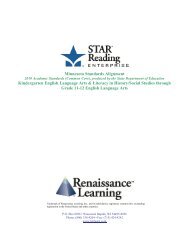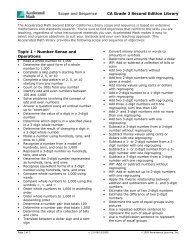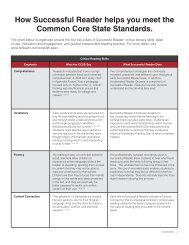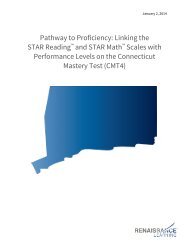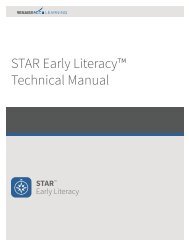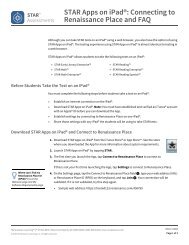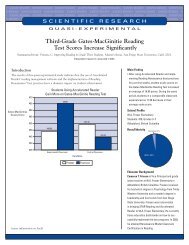New Thinking in Response to Intervention - Renaissance Learning
New Thinking in Response to Intervention - Renaissance Learning
New Thinking in Response to Intervention - Renaissance Learning
Create successful ePaper yourself
Turn your PDF publications into a flip-book with our unique Google optimized e-Paper software.
To moni<strong>to</strong>r Juanita’s progress, STAR-EL was<br />
adm<strong>in</strong>istered weekly as seen <strong>in</strong> Figure 7. At<br />
first, Juanita did not show a growth rate equal<br />
<strong>to</strong> her goal. The team decided <strong>to</strong> change the<br />
<strong>in</strong>tervention after 5 weeks.<br />
The change <strong>in</strong> <strong>in</strong>tervention resulted <strong>in</strong> substantial<br />
improvement <strong>in</strong> Juanita’s performance that<br />
actually surpassed the level of expected growth<br />
STAR scaled scores represent a<br />
set of skills students have a high<br />
probability of know<strong>in</strong>g. This is<br />
a fundamental element of CAT:<br />
student performance is placed on a<br />
developmental scale.<br />
<strong>in</strong>itially set for her. Based on her w<strong>in</strong>ter universal screen<strong>in</strong>g, the team will exam<strong>in</strong>e Juanita’s data and decide if<br />
she is still <strong>in</strong> need of the tiered <strong>in</strong>tervention support. STAR-R and STAR-M also provide similar opportunities <strong>to</strong><br />
conduct progress moni<strong>to</strong>r<strong>in</strong>g for students who are receiv<strong>in</strong>g supplemental tiered <strong>in</strong>terventions.<br />
STAR moni<strong>to</strong>rs progress us<strong>in</strong>g scaled scores. STAR scaled scores represent a set of skills students have a<br />
high probability of know<strong>in</strong>g. As a result, educa<strong>to</strong>rs can run reports that suggest the skills students scor<strong>in</strong>g at<br />
470 versus 400 should have mastered, thus identify<strong>in</strong>g potential targets for <strong>in</strong>tervention. This is a fundamental<br />
element of all CAT measures: Student performance is placed on a developmental scale such that all students<br />
who score at the same level, regardless of grade, are essentially at the same po<strong>in</strong>t <strong>in</strong> the progression of skills<br />
result<strong>in</strong>g <strong>in</strong> that score.<br />
Student Progress Moni<strong>to</strong>r<strong>in</strong>g Report<br />
Pr<strong>in</strong>ted Thursday, January 13, 2011 3:15:23 PM<br />
School: East Elementary Report<strong>in</strong>g Period: 9/16/2009-1/22/2010<br />
(Cus<strong>to</strong>m)<br />
1 of 2<br />
Vargas, Juanita<br />
Grade: 1<br />
ID: P234U8<br />
Class: G1 - Davos<br />
Teacher: Davidson, M.<br />
700<br />
650<br />
STAR Early Literacy Scaled Score<br />
600<br />
550<br />
500<br />
450<br />
Sep-10 Oct-10 Nov-10 Dec-10 Jan-11<br />
Test score<br />
Trend l<strong>in</strong>e Goal l<strong>in</strong>e Goal<br />
<strong>Intervention</strong> change<br />
Juanita's Current Goal<br />
Goal: 581 SS Goal End Date: 1/22/2010<br />
Expected Growth Rate: 5.6 SS/Week<br />
Figure 7. Progress moni<strong>to</strong>r<strong>in</strong>g on STAR-EL for a student <strong>in</strong><br />
need of tiered support.<br />
16





